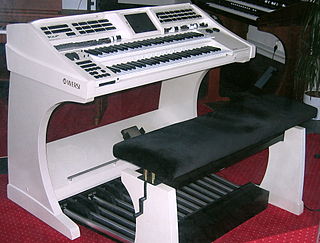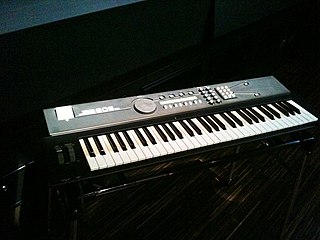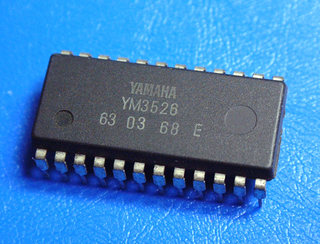
A digital synthesizer is a synthesizer that uses digital signal processing (DSP) techniques to make musical sounds. This in contrast to older analog synthesizers, which produce music using analog electronics, and samplers, which play back digital recordings of acoustic, electric, or electronic instruments. Some digital synthesizers emulate analog synthesizers; others include sampling capability in addition to digital synthesis.
General MIDI is a standardized specification for electronic musical instruments that respond to MIDI messages. GM was developed by the American MIDI Manufacturers Association (MMA) and the Japan MIDI Standards Committee (JMSC) and first published in 1991. The official specification is available in English from the MMA, bound together with the MIDI 1.0 specification, and in Japanese from the Association of Musical Electronic Industry (AMEI).

A digital piano is a type of electronic keyboard instrument designed to serve primarily as an alternative to the traditional acoustic piano, both in the way it feels to play and in the sound produced. Digital pianos use either synthesized emulation or recorded samples of an acoustic piano, which are sounded through an internal loudspeaker. They also incorporate weighted keys, which recreate the feel of an acoustic piano. Some digital pianos are designed to also look like an upright or grand piano. Others may be very simple, without a stand.

Korg Inc., founded as Keio Electronic Laboratories, is a Japanese multinational corporation that manufactures electronic musical instruments, audio processors and guitar pedals, recording equipment, and electronic tuners. Under the Vox brand name, they also manufacture guitar amplifiers and electric guitars.

An electronic keyboard, portable keyboard, or digital keyboard is an electronic musical instrument, an electronic or digital derivative of keyboard instruments. Broadly speaking, the term electronic keyboard or just a keyboard can refer to any type of digital or electronic keyboard instrument. These include synthesizers, digital pianos, stage pianos, electronic organs and digital audio workstations. However, an electronic keyboard is more specifically a synthesizer with a built-in low-wattage power amplifier and small loudspeakers.

The Yamaha QY10 is a hand-held music workstation produced by the Yamaha Corporation in the early 1990s. Possessing a MIDI sequencer, a tone generator and a tiny single-octave keyboard, the portable and battery-powered QY10 enables a musician to compose music while traveling.

The Clavinova is a long-running line of digital pianos created by the Yamaha Corporation. The name is a portmanteau of the two words Clavier meaning 'keyboard instrument' and nova meaning 'new'.
Electone is the trademark used for electronic organs produced by Yamaha. With the exception of the top end performance models, most Electones are based on the design of the spinet electronic organ. Current models are completely digital and contain a variety of sounds, effects, and accompaniments, on top of the ability to store programming data onto memory devices.
Monotimbral is usually used in reference to electronic synthesizers which can produce a single timbre at a given pitch when pressing one key or multiple keys.
Keyboard expression is the ability of a keyboard musical instrument to change tone or other qualities of the sound in response to velocity, pressure or other variations in how the performer depresses the keys of the musical keyboard. Expression types include:

The Yamaha GX-1, first released as Electone GX-707, is an analog polyphonic synthesizer organ developed by Yamaha as a test bed for later consumer synths and Electone series organs for stage and home use. The GX-1 has four synthesizer "ranks" or three manuals, called Solo, Upper, and Lower, plus Pedal, and an analog rhythm machine. The GX-707 first appeared in 1973 as a "theatre model" for use on concert stages, before the GX-1 was publicly released in 1975.

The Yamaha Motif is a series of music workstation synthesizers, first released by Yamaha Corporation in August 2001. The Motif replaced the EX series in Yamaha's line-up and was also based on the early Yamaha S series. Other workstations in the same class are the Korg Kronos and the Roland Fantom G. The series' successor is Yamaha Montage.
Polyphony is a property of musical instruments that means that they can play multiple independent melody lines simultaneously. Instruments featuring polyphony are said to be polyphonic. Instruments that are not capable of polyphony are monophonic or paraphonic.

Open-Architecture-System (OAS) is the main User interface and synthesizer software of the Wersi keyboard line. OAS improves on prior organ interfaces by allowing the user to add sounds, rhythms, third party programs and future software enhancements without changing hardware. Compared to previous organs which relied on buttons, OAS uses a touch screen to make programming easier. OAS can host up to 4 separate VST software instruments, allowing for an expandable system similar to the Korg OASYS. OAS can support dynamic touch and aftertouch, but cannot support horizontal touch like the Yamaha Stagea Electone.
The Yamaha YMF278B, also known as the OPL4, is a sound chip that incorporates both FM synthesis and sample-based synthesis by Yamaha.

The Yamaha YS200 is an FM synthesiser and workstation produced by Yamaha, introduced in 1988. It combines a sequencer, rhythm machine, an FM synthesis soundchip and a MIDI keyboard. It was called the EOS YS200 in Japan and was also released as a more home-oriented keyboard in the form of the Yamaha EOS B200, which also featured built-in stereo speakers. The YS200 is the keyboard equivalent of the Yamaha TQ5 module. The forerunner of the YS200 was the almost-identical Yamaha YS100.

The Yamaha PSR-E323, also known as the YPT-320, is an electronic keyboard manufactured by the Yamaha Corporation in 2009. It is a basic home keyboard intended for learning and personal use.
The Yamaha PSR-550 is a portable arranger workstation electronic keyboard produced in 2001.

The OPL series were developed by Yamaha as low-cost sound chips providing FM synthesis for use in computer applications.















